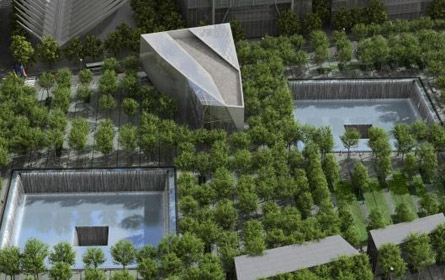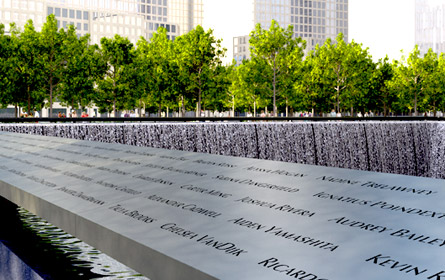
On the 10-year anniversary of the Sept. 11, 2001 attacks, the National September 11th Memorial will open to the public. This event marks the end of a process that began with an international design competition that yielded 5,201 submissions from 63 nations. The magnitude, emotional investment, and symbolism of this project created a complex, drawn-out and sometimes chaotic process involving conflicting visions, ambitious designs, financial concerns and, above all, long deliberations with multiple parties, particularly the families who lost loved ones on that tragic day.
On the site where the twin towers of the World Trade Center once stood, an 8-acre memorial and underground museum will commemorate those who lost their lives in the attacks and educate millions of visitors who will come to pay tribute to the victims of 9/11 and learn about the history of that day. The memorial will transform what was once the concrete of Ground Zero into a plaza flanked by trees and punctuated by two reflecting pools in the footprints of the original Twin Towers. Between the pools, the pavilion will provide an entrance into the museum, leading visitors from the memorial plaza, a space of contemplation, to exhibitions filled with first person accounts, remnants from the Word Trade Center site, and historical information about 9/11.
Even as the museum and memorial come to completion, construction around the site will continue, and as a result, the Memorial will require visitors to reserve passes in advance.
"The development of the 9/11 memorial and museum takes place at the arguably most complicated construction site on the planet. For starters, the memorial and museum rests on a transit hub with multiple rail lines, a state of the art security area, a massive underground parking lot, infrastructure to support at least four office towers, and it's on a landfill," explained Kate Levin, commissioner of the city's Department of Cultural Affairs, at a recent forum at the New York Times. "The project also has extraordinarily passionate and diverse stakeholders from family members whose loved ones perished on Sept. 11 to local residents, elected officials, property owners, the general public and the world at large. "
Design Plans Underway
The city hopes that memorial's design by Michael Arad will please most, if not all, of those care so deeply about the project.
Arad, began sketching soon after the attacks. He envisioned two voids in the Hudson River that remained empty.
When the Lower Manhattan Development Corp. design competition launched, he re-imagined those two voids at the site of the World Trade Center and submitted his proposal. A 13-person jury -- including Paula Grant Berry, a memorial board member who lost her husband in the 9/11 attacks, and Maya Lin, the architect of the Vietnam Veterans Memorial among others -- selected Arad's design out of thousands of submissions.
Ten years later, Arad’s idea has come to fruition: Reflecting pools with waterfalls have been placed within the footprints of the twin towers, and a grove of trees fills the Memorial Plaza. Arad collaborated with landscape architecture firm Peter Walker and Partners, and together, they came up with the idea to plant 400 swamp white oak trees, creating a canopy of leaves, which will turn gold and amber colored around Sept. 11.
Progress has been made as the deadline for Sept. 11 nears— so far, 400 trees have taken root, and the 30-foot waterfalls have been successfully tested. After consulting with families, the architects have finalized the most important component of the memorial -- the arrangement of victims' names that will be inscribed on bronze parapets surrounding the two reflecting pools.
.
Honoring The Lives Lost
The arrangement of the names stirred much debate among families of 9/11 victims. In early May, the memorial staff and architects announced the final placement of the nearly 3,000 names around the two reflecting pools. They created a system of what they call "meaningful adjacencies" that show where the victims were killed on 9/11, such as Flight 11, the Pentagon or the North Tower. The designer and others also invited next of kin to request that certain names be listed together with those of colleagues, friends or relatives.

Throughout the process Some families, along with some police and firefighter groups, expressed their disappointment that the wall will not list the age, company name and rank of uniformed personnel. Others, however, feel reassured by the final arrangement of names.
Anthoula Katsimatides lost her brother, John Katsimatides, a bonds broker at Cantor Fitzgerald, in the attacks. For the last few years she also has worked at the Lower Manhattan Development Corp. and served on the memorial board. She thinks the eventual solution is fitting.
"All these little nuances about how the names should be listed. At the end of the day, isn't it better to have the name in its simplicity listed?" she said. "The families were clamoring because the design originally called for a random listing of the names, which upset many of the family members. And then Michael Arad came up with this similar meaningful adjacency process. And now I know that my brother, for example, will be listed next to the three guys he worked with every single day. I take comfort in that."
The memorial will list names of the victims in nine groups, such as those who lost their lives when the flights crashed into the World Trade Center complex or first responders who died in the line of duty. However, the names of the recovery workers – even those who have died in the years and months since because of their exposure to toxins at the site -- will not be inscribed on the memorial.
At the forum, 9/11 Memorial president, Joseph Daniels, explained, "The memorial itself ... will have the names of the 2,983 victims, that by policy, the city's medical examiner has classified as a 9/11 homicide, they will be the names around the memorial. The story of the recovery workers who sacrificed, got sick and are dying is an absolutely essential part of this project and within the museum itself. We will be telling that story and we will be recognizing the individuals who sacrificed and who died, and it is an incredibly important part of the narrative."
Entrance to the Museum
The memorial will serve as a place of reflection by visitors from around the world, but the details, personal stories, and history behind 9/11 will be told in greater depth through permanent and temporary exhibitions in the museum. After weathering many changes over the last few years, the pavilion designed by Norwegian architecture firm Snøhetta is halfway to completion -- with the exterior scheduled to finish this year and the construction on the interior set to wrap up in September 2012, just in time for the official opening of the museum.
Situated between the two reflecting pools, the pavilion not only serves as the entrance to the museum, but also houses an auditorium for public programming, a space for contemplation, a counter for refreshments, and a private suite for families who lost loved ones in the attacks. Inside the pavilion’s glass atrium, two of the original steel tridents from the Twin Towers will stand on display.
"Our desire is to allow visitors to the site to find a place that has a naturally occurring threshold between the everyday life of the city and the uniquely spiritual quality of the memorial. The building should engage the visitor directly and allow each person to find themselves mirrored within the unique setting," wrote Craig Dykers of Snøhetta. "It is important that people physically engage with the building and feel that the building helps lead them on to other areas of the site and other thoughts about their experiences there."
From the pavilion, the National September 11 Museum takes visitors 70 feet below ground down to the bedrock level where the original foundations of the Word Trade Center are displayed. The museum honors those whose lives were lost in the attacks with audio and visual components and remembrances and also tells the story of 9/11 through oral histories, artifacts, digital documentation, photographs and video.
The museum will be divided into three spaces: a historical exhibition centered around the attacks as well as what led to them and their significance; a memorial exhibition; and the West Chamber, containing remnants from the attacks including the slurry wall and the last column.
"Fundamentally the objectives of the museum are threefold. First, to be the global focal point for the telling the story of what happened on 9/11 told through first person accounts, artifacts, and digital documentation. Second, the museum will address how the events happened including the rise of Al Qaeda, the precursor events throughout the 1990s, and the 9/11 plot itself," said Daniels. "And third, the museum will explore the big societal questions. What does this mean for our future that continue to define the post 9/11 world in which we live?"
One of the challenges that director of the Memorial Museum Alice M. Greenwald, faces is how to handle the sensitive nature of the material. While aspects of the events memorialized and depicted can be unsettling, they are essential parts of the story. Daniels addressed this issue at the forum. "We are going to be presenting the sensitive material, but we're going to do it in a way that clearly lets people who don't want to see it go around it," he said.
Different Points of Views
The National September 11th Museum and Memorial already has elicited a range of responses -- some families support the plans, while others are critical.
Jane Pollicino, who lost her husband, Steve Pollicino on 9/11, expressed her disappointment that the Sphere sculpture, which survived the attacks, will not be on the plaza. "The Sphere, which became a symbol of survival, hope for the world; and as always an icon representing peace, should have had a prime location between the footprints of the towers," she said. "I do understand the complexity and the issues that the city faced in the entire rebuilding process. It has been one of the most complicated construction projects in our nation and so many people have so many different opinions."
Herbert Ouida’s son, Todd Ouida, worked at Cantor Fitzgerald and lost his life on 9/11. He said, "People argue about everything, what they really want is to have their loved ones back. We haven't gotten involved in those issues -- it doesn't make a difference if the museum is upstairs or downstairs. The government is trying to compensate the best they could. Let's make the world safer than on 9/11."
Nicole Anderson is a freelance writer based in Brooklyn. Her website is here.